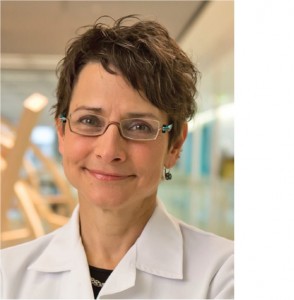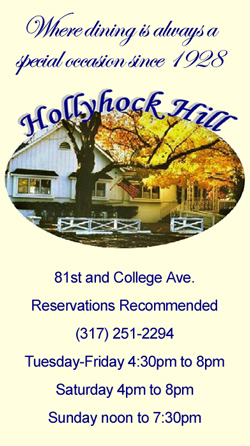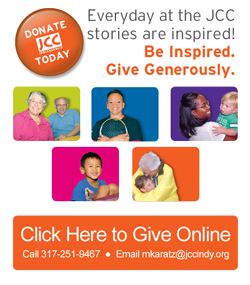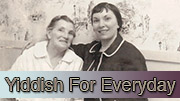
Our Health, Our Future
By Dr. Lisa Harris, CEO Eskenazi Health
The following is an excerpt of a speech given from the pulpit of Congregation Beth-El Zedeck in Indianapolis on Sept.6, 2014 at the Bat Mitzvah of Ella Eskenazi.
I have always admired the Jewish tradition for its focus on social responsibility, for the deep sense of personal obligation and humanity’s shared responsibility, encompassed in the Hebrew phrase Tikkun olam, to heal, repair and transform the world, leaving it a better place for our brief presence in it. So, though I had certainly heard the rhetoric – “if not us, who, if not now, when,” – I wasn’t surprised to learn from the Rabbis Dennis and Sandy Sasso that it originated with Hillel the Elder, one of the most important leaders in Jewish history, who put it like this:
“If I am not for myself, who will be for me? If I am for myself alone, what am I? And if not now, when?”
When Rabbi Dennis Sasso spoke these words as he and Sandy explained to me how the Bat Mitzvah signals the age of moral discernment and therefore moral responsibility – of higher obligation and accountability for one’s actions – he sent chills up my spine.
These words resonate powerfully with me from many perspectives. The one I want to focus on this morning, though, is not only the notion of personal responsibility for one’s own health, but our responsibility for the health and vitality of all those living within our community – and the good that can transpire from taking on that responsibility.
Because good health provides the foundation for everything else we aspire to individually and collectively.
If I am not for myself, who will be for me?
The notion of personal responsibility for health and the powerful impact that personal decisions and behaviors have on health and wellbeing is at the core of our approach to care at Eskenazi Health. Because we know that if we wait until the point at which we’re treating chronic disease, we have only a 10% opportunity to reduce the risk of premature death.
That’s right. 10%.
The biggest opportunity, 50%, lies in personal lifestyle – good nutrition, and regular physical activity, but also connection to nature, social connection, and strong ties to family, friends and community.
Another 20% lies in the environment – clean air and water, certainly, but also safe workplaces, homes and roads, a built environment that enables good health behaviors, for example, easy access to healthful foods and sidewalks that are in good repair.
The remaining risk lies in the genetic blueprint we’re born with. However, only about 2 percent of deaths in the US can be attributed to purely genetic disease and even for a problem like obesity, for which almost two-thirds of the risk may be genetic, the risk is almost entirely controllable by lifestyle choices.
So close to 90% of the responsibility for health is on us. The biggest opportunity for living a long, vibrant life lies in our daily habits.
And to give you a sense of the power that lies with the personal choices we make:
A while back we were part of a national study that randomly assigned half of a group of patients to 30 minutes of daily exercise and a low-fat diet and the other half to a drug used to treat diabetes, to see which approach was most effective in reducing the risk of diabetes. The study was stopped early because it would have been unethical to continue, given that the participants receiving the medication were not benefitting from the dramatically better outcome experienced by the group receiving the lifestyle intervention: exercise and diet reduced the risk of developing diabetes by 60%!
There really isn’t much we can do in terms of treating disease that has anything close to this powerful an effect.
This is why we see it as our responsibility not just to take care of you when you’re sick or injured, but to do everything we can to help you stay well in the first place. And it’s why we spend a lot of time working to help create and support the kind of environment here in Indianapolis that makes good health possible for everyone living in our community.
It’s why we offer free personalized health coaching throughout our primary care practices and it’s why, within a few months, we’ll have the capacity to download the data from personal fitness tracking devices right into our patients’ medical records, so that physicians can monitor not only the usual weight, blood pressure and heart rate, but also physical activity, one of the most important contributors to health.
But it isn’t only about being active and eating right, it’s about connection to nature, a rich cultural and spiritual life and, perhaps most important, social connection – caring for each other.
To have the kind of effect we need, though, if we’re going to have a community that supports the quality of life we all want, that connection, that caring, has to extend beyond the familiar network of family and friends, it has to reach across the breadth of our community.
“If I am for myself alone, what am I?”
We are also responsible for the well-being of our neighbors.
Over the past several decades, though, there’s been a widening gulf between the “haves” and the “have not’s.”
And that’s a big problem, not only for those who are left behind, but for everyone living within our community, because we are all affected by the consequences of poverty; increasing crime, resources directed toward a growing burden of chronic disease and away from education and creating the kind of environment that enhances quality of life for all.
Rather than allowing the social separation that can come with widening income inequality, we need to stick together, engaged in dialogue, reaching across social and economic divides in the interest of greater mutual understanding and support. We can’t very well repair the world if we’re oblivious to where it’s broken.
By way of example, let me tell you what played out at Eskenazi Health: Blackburn , one of our inner-city health centers, a couple of weeks ago.
It was 7:00 in the evening; everyone had left for the day, when the burglar alarm went off. One of our security guards responded, finding a young black male with a tablet computer under his arm at the back door.
As he approached the young man, an older brother ran out of a house across the street, accompanied by several of his friends.
There was a lot of posturing.
Our officer called for back-up, and soon there was quite an assembly. Tensions were high in that parking lot.
This could have gotten ugly, and if it had, you likely would already have heard the story. But that’s not what happened. As it turned out, one of the individuals responding to the call for back-up was Kelley Hayworth, a member of our security staff, who was on his way home when he got the call. He recalls that the thought on his mind, as he turned his car around was: “this can’t go bad.”
It didn’t.
What ensued was an interaction between Kelley and the young man’s older brother, in which Kelley worked first to defuse the tension and then orchestrated a dialogue that acknowledged mutual concern for the safety and well-being of those living in the neighborhood, appreciation and respect for all those working in the interest of the neighborhood and the need to understand the importance of the roles each played. Eventually, everyone went home.
And what do you think the young man was doing with a tablet computer outside our health center?
His homework.
His home didn’t have internet access, so he was tapping into our wi-fi. (We’re working to amp up the signal so it reaches a little farther.)
Kelley and I talked about this after I’d heard the story several days later. One of his main reasons for wanting to make sure things went well is that he didn’t want anyone in the neighborhood surrounding Blackburn to feel as though they couldn’t turn to us in the future for care and understanding. I love how, as a security guard, he unassumingly embodies the most important values we hold as an organization.
This capacity for compassion and understanding is especially important to us because of one of the singular roles we play in our community. Yes, we care for faculty members and their families, business leaders and philanthropists. But, as a level 1 trauma center, we also care for victims of violent crime.
And, in the past, it was the case that if an individual survived being shot or stabbed the first time (as most do), there was a 32% chance that they would return within 2 years, again a victim.
We thought it was a problem that these individuals were on first-name basis with our trauma surgeons, so we started Project Prescription for Hope, hiring a
couple of individuals, who had themselves at one time been caught up in the web of violence, but who had done the hard work of putting themselves on another path.
They began working with these victims in the context of their social milieu, their families, their gangs, to address the factors that got them headed down this self-and- community-destructive path and, within a couple of years, we had reduced the rate of violence recidivism from over 30% to less than 5%.
The program has many components, one of which is a group-based anger management program similar to the alcoholics anonymous sponsorship approach. When the first group of individuals had managed 9 months without an outburst of violence among them, we asked them what they wanted to do to celebrate. Within reason, pretty much anything was on the table.
What did they want to do? They wanted to go to King’s Island.
They’re not thugs. They’re kids.
They don’t need to be locked away. They need our understanding and our help
“If not now, when.”
Well, getting back to the notion of personal responsibility for health, Ella, for you and all of your friends, though it’s never too late, now is the best time to establish those daily habits.
Eat your fruits and veggies, stay away from the junk (you know what that is!) – get moving! Find ways to get out into nature – spend time with your family and friends, get these habits set now and they will help you all through your life.
(That’s not to say, though, that you all shouldn’t enjoy the Candy Bar at the Children’s Museum tonight – a party, after all, is a party!)
For that notion of our broader responsibility, there’s a sense of urgency.
We’re faced with an epidemic of obesity and related chronic illness that’s consuming enormous resources, resources that could otherwise be spent on education, on investment in the public infrastructure that enhances life for all of us. Just this week, the IBJ reported that Indiana is spending $585 more per person annually on health care than is spent, on average, across the US.
Indianapolis was recently ranked #2, behind Seattle, among US cities in terms of cultural activities and attractions per capita, but everything we’ve achieved in recent years is at risk because of the alarming upsurge in violence that has its roots in poverty, lack of investment in early education, and the social support necessary throughout childhood and adolescence, without which the result is social drop-out.
At the same time, though, positive momentum builds within our city.
Think of the cultural trail, all the yellow bikes out there, the urban agriculture initiative. You have a great example, Ella, at the Legacy Center where the Patatruck is based. What a great opportunity the Patatruck project and the urban gardens that are springing up around Indianapolis offer for bringing us together in the interest of broader engagement and understanding across the breadth of our community.
Who knows where what you’re doing to help the children there might lead?
The SkyFarm on top of our outpatient care center, where we’re now harvesting over 100 pounds of produce a week, had its roots in a greenspace on our old campus where employees tended small plots of ground. Who would have imagined?
We developed our entire campus to contribute to the positive momentum growing within our community.
Because we believe that our campus, with patients, staff, faculty and medical students coming from all corners of the globe and all walks of life, represents one of our community’s most diverse intersections. So we developed the Commonground at the heart of our campus as a space where all are welcome and all are celebrated, a space that increase the likelihood of coming together across the broad social landscape.
And we are grateful to your family and so many others across our community for the generous gifts that allow us to carry on our long legacy of caring for everyone within our community, and now in an environment deliberately designed to lift the spirits both of our patients and those who care for them.
Central to this healing environment is a public art program, one of my favorite pieces of which is a sculpture comprised of intertwining ladders made of Indiana maple. The artist, Aaron Stephan, named it “Paths Crossed,” for the ways our lives intersect on our various paths from health to the challenges of illness and back to health again.
The message that Aaron is conveying with his art is the same message that Kelley delivered in the parking lot behind Blackburn: the business of caring and support doesn’t go just one way – we all bring resources to the mix – we all have something to give and to learn.
Ella, you come from a religious tradition that asks big questions, questions that are as important today as they were nearly 2,000 years ago.
“If I am not for myself, who will be for me? If I am for myself alone, what am I? And if not now, when?
And you are fortunate to come from a family that strives to live by example the answers to those questions.
Take good care of yourself. Figure out what you can do to take good care of your world and do it. It’s waiting for you.
Dedicating her career to improving health care for vulnerable and underserved populations, Lisa E. Harris, M.D., has practiced medicine for 30 years at nationally recognized Eskenazi Health (formerly Wishard Health Services). Today, Dr. Harris serves as Eskenazi Health’s chief executive officer (CEO). In addition, Dr. Harris is engaged in research and teaching as the John F. Williams, Jr., M.D. scholar; associate professor of medicine; and associate dean for the IU School of Medicine.
Annabella Morris Eskenazi (Ella) is the daughter of David and Julie Eskenazi, and the granddaughter of Sidney and Lois Eskenazi and Sally and Jerry Sussman. In June 2011Sidney and Lois Eskenazi provided a $40 million gift to the Eskenazi Health Foundation to build new hospital facilities in downtown Indianapolis.






